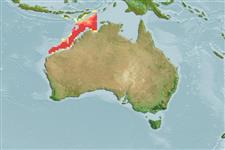Common names from other countries
Пластиножаберные (акулы и скаты) (sharks and rays) >
Rhinopristiformes (Shovelnose rays) >
Rhinobatidae (Guitarfishes)
Etymology: Rhinobatos: Greek, rhinos = nose + Greek, batis, -idos = a ray (Raja sp.) (Ref. 45335); sainsburyi: Named for Dr. Keith Sainsbury..
More on author: Last.
Environment: milieu / climate zone / depth range / distribution range
экология
морской донно-пелагический; пределы глубины 66 - 200 m (Ref. 58070), usually ? - 150 m (Ref. 58070). Tropical; 5°S - 21°S, 114°E - 135°E (Ref. 114953)
Eastern Indian Ocean and Western Central Pacific: Western Australia to Papua New Guinea
Size / Вес / Возраст
Maturity: Lm ? range ? - ? cm
Max length : 59.5 cm TL самец/пол неопределен; (Ref. 58070)
Краткое описание
определительные ключи | морфология | морфометрия
This species is distinguished by the following characters: wedge-shaped disc, its dorsal surface scaled but no thorns; snout length 2.5-2.6 times interspiracular distance; orbit moderately large, diameter 1.6-1.9 times spiracle length; nostrils oblique, length 1.4-1.6 times internarial distance; anterior nasal-flaps inserted well into internarial space, but never almost united near ventral midline; posterior nasal flaps broad; ridges of rostral cartilage well-separated dorsally and almost parallel; prebranchial sensory-pore patch narrow, extending to first gill slit; distance between first gill slits 1.3-1.4 times distance between fifth gill slits; distance between fifth gill slits 2.5-2.9 times in ventral head length; postscapular sensory canal long, not grooved, extending more than three-quarters distance to pectoral-fin insertions; moderately tall dorsal-fins; pelvic-fin inner margin distinctly longer than its base in mature males, shorter than base in females; interdorsal distance more than 2.5 times first dorsal-fin base; outer spiracular fold distinctly larger than inner fold; dorsal margin of caudal fin about 2.0-2.2 times preventral margin; 162-171 post-synarcual vertebral centra; about 50 nasal lamellae; dorsal disc plain brownish or with faint dusky blotches or fine dark spots (Ref. 58070).
This species is mostly collected at depths shallower than 150 m. Male individuals mature at 46 cm TL, immature at 37.6 cm TL (Ref. 58070).
Life cycle and mating behavior
Maturities | размножение | Spawnings | Egg(s) | Fecundities | личинки
Last, P.R., 2004. Rhinobatos sainsburyi n. sp. and Aptychotrema timorensis n. sp. -- two new shovelnose rays (Batoidea: Rhinobatidae) from the eastern Indian Ocean. Rec. Aust. Mus. 56(2):201-208. (Ref. 58070)
Статус Красного Списка МСОП (Ref. 130435)
Угроза для людей
Harmless
Использование человеком
дополнительная информация
инструменты
Специальные отчеты
Скачать в формате XML
ресурсы в Интернет
Estimates based on models
Preferred temperature (Ref.
115969): 20.5 - 26.8, mean 23.9 (based on 45 cells).
Phylogenetic diversity index (Ref.
82804): PD
50 = 0.5000 [Uniqueness, from 0.5 = low to 2.0 = high].
Bayesian length-weight: a=0.00295 (0.00151 - 0.00578), b=3.13 (2.96 - 3.30), in cm Total Length, based on LWR estimates for this (Sub)family-body shape (Ref.
93245).
Trophic level (Ref.
69278): 3.7 ±0.4 se; based on size and trophs of closest relatives
устойчивость к внешним воздействиям (Ref.
120179): низкий, минимальное время удвоения популяции 4.5-14 лет (Preliminary low fecundity).
Fishing Vulnerability (Ref.
59153): Moderate vulnerability (44 of 100).
